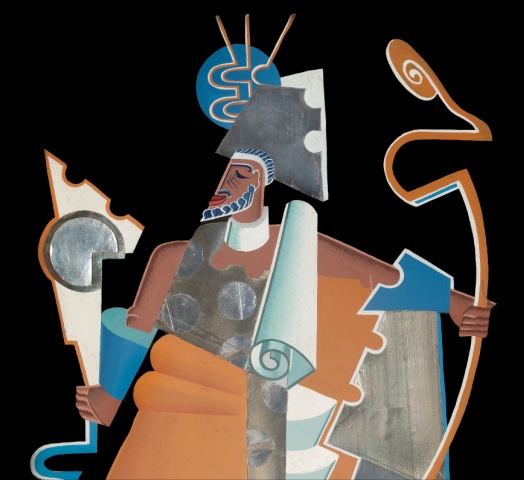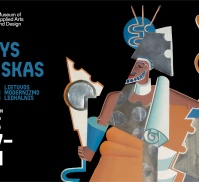Stasys Ušinskas: The Iceberg of Lithuanian Modernism
The exhibition "Stasys Ušinskas: The Iceberg of Lithuanian Modernism" at the Museum of Applied Arts and Design.
17 April – 14 September 2025.
Stasys Ušinskas (1905–1974), born to a stone-cutter from Pakruojis on the Lithuanian-Latvian frontier, rose to the top of his artistic career in the 1st half and the middle of the 20th C. Of his contemporaries on the Lithuanian art stage, Vytautas Kairiūkštis (1890–1961) may compare to him in their avant-garde aspirations, yet on the whole Ušinskas’s multifaceted talent at home knew no equals: a superb painter and draughtsman, a virtuoso of multiple figure compositions, a revolutionary stage designer, book illustrator, stained-glass and decorative glasswork artist, puppeteer, animator and a pedagogue. His brave invention of new stylistics and use of different media, techniques and technologies, his avid reinvention of himself across a range of art fields, set him firmly, in contrast to Expressionists, on the path of constructive and decorative art. The groundbreaking pieces by the artist featured at his birth centenary exhibition in Kaunas were aptly encapsulated as the ‘constructions of volitional beauty’.
Stasys Ušinskas’s pioneering contribution embraces so many areas. The artist is considered the father of modern Lithuanian stained-glass was also the founder of professional puppet theatre and the forerunner of Lithuanian animation. 6 May 1936, when Metropolitain Film Theatre in Kaunas gave the first-night of Silverstas Dūdelė (Silvestras the Pipe), a play of marionette puppets, gave rise to the puppeteers’ professional holiday in the country. Stasys Ušinskas was the maker of the first Lithuanian puppet-animated sound film The Dream of the Fatty (1938). His ideas for stage designs for the opera and drama productions show a new approach in the planning and constructing of the visual space for the stage ‘box’, in contrast to the task of deciding how and where to hang the already produced paintings and to how to “decorate” the stage. Ušinskas produced inspired scenic and costume designs for the State Theatre productions, examples being J. R. Planquette’s Les cloches de Corneville, A. de Musset No Trifling with Love, W. Shakespeare’s Twelfth Night, or What You Will, Johann Strauss’s operetta The Gypsy Baron. Ušinskas’s biggest achievement for stage productions was his scenic and costume design for Balys Dvarionas’s ballet The Matchmaking. His modern Lithuanian folk costume designs show tactful humour, while his brave alterations to the traditional silhouettes, shapes and patterns resulted in the appearance that strikes as modern even today.
Stasys Ušinskas was born in Pakruojis on 21 July 1905. As a child, he spent several years in the USA with his parents. His first acquaintance with art was via the art collections at Pakruojis manor house of von de Ropp family, where the future artist’s grandfather served. Upon coming back to Lithuania, in 1920 – 1921, he studied at Linkuva Pre-gymnasium, and for subsequent four years, at Šiauliai State Gymnasium. He lodged at the dormitory Žiburėlis provided by the Pupils and Students’ Society, which helped needy students. Ušinskas was supported with a stipend from the organization, too. In 1925 – 1929, he enrolled at Kaunas Art School where he attended Justinas Vienožinskis’s painting studio. Yet he was excluded from the school for participating in students’ strike and for adding his signature to a letter to the education minister.
In 1929–1933, he studied (with intermissions) in Paris. He took classes in drawing and composition at the private Académie Julian and studied at the Conservatoire National des Arts et Métiers graduating from the school on 1 July 1933 with a diploma in stained-glass and stage design. While in Paris, he also studied at the private Fernand Léger’s Académie Moderne under Alexandra Exter (his graduation project was drawings for the set and costume design for Sophocles’ Oedipus the King and Shakespeare’s Othello.)
Stasys Ušinskas embarked on his career at home with an amazing intensity already in 1930, the year that saw Lithuania commemorating 500 years since the death of Vytautas the Great. Ušinskas managed to take on his creative projects in Lithuania together with his studies in Paris. In 1930, he organized his solo exhibition in Šiauliai, and in 1931, in Kaunas, gaining positive acclaim for his stylistic innovations.
While in Paris, Ušinskas got interest in stained-glass technique and started producing exhibition pieces as well as projects for the churches and interiors of public buildings, using classical technique of thin glass sheets for stained-glass work. From the middle of the 1950s, he started experiments in decorative glassworks. He was the first in Lithuania using mirror and thick glass slabs for stained-glass projects. He adopted low-temperature-firing to make coloured glass vases, plates, drinking glasses, chalices, decorative and everyday glassware.
In 1936, Ušinskas visited the United States of America, while his half-a-year sojourn in the country at the turn of 1937 – 1938 was especially intense. In 1937, he organized his solo exhibit at the Rogers Gallery in New York, and in 1938, he produced scenic and costume designs for Strindberg’s The Bridal Crown (stage director A. Oleka – Žilinskas) at the Broadway Theatre, and for Euripides’s The Trojan Women directed by M. Hunter at the Nicholas Roerich Museum’s Theatre, New York City.
In 1939, only in his mid-forties, Ušinskas reached the summit of his career. The Lithuanian Pavilion at the 1939 New York World’s Fair showcased three of the artist’s monumental pieces: two historic canvases, The 1429 Congress of Lutsk (Vytautas the Great in the Castle of Lutsk) and Grand Duke of Lithuania Algirdas Striking His Sword Against the Kremlin Gate in Moscow in 1369, and a panel, Lithuania (Lithuanian School). The three pieces were state commissions. The panel Lithuania displayed, in a highly artistic and optimist manner, the obvious progress of education in the emerging modern state. These historical paintings, according to Prof Giedrė Mickūnaitė, “represent the expectations of the past. Paradoxically, none of these hopes reached fruition: Algirdas never took Moscow, Vytautas failed to be crowned king, thus the paintings seem to represented the bygone potential of the country, which the modern State of Lithuania now sought to realize.’
Ušinskas’s puppet-animated sound film The Dream of the Fatty (camera Alfonsas Žibas, composer Stasys Gailevičius) was also screened at the New York World’s Fair. In 1939, the American cartoon company Dal-company commissioned a new production based on Hans Christian Andersen’s fairy tale The Nightingale, and the next year he drew sketches for five puppet-marionette characters. In all likelihood, Stasys Ušinskas received invitations from American companies to draw sketches and make models for mass production of toys. The outbreak of World War Two thwarted all the plans and possibilities of creative work for foreign clients.
Stasys Ušinskas was also an art pedagogue, active in different teaching positions all the time: in 1933–1940 he taught at Kaunas Art School (from 1935, headed the Decorative Painting Studio). Holding professorship from 1946, during postwar years, he taught at Kaunas Applied and Decorative Art Institute, Vilnius State Art Institute, Kaunas Polytechnical Institute, Vilnius Engineering and Construction Institute. He developed teaching aids and materials, “Karpymo sąsiuvinys” (Workbook for Cutting) (K., 1937), “Lėlių ir kaukių teatras” (Theatre of Puppets and Masks) (V., 2005)
Stasys Ušinskas died on 14 June 1974 in Kaunas, and rests in Romainiai Cemetery.
After the screening of The Dream of the Fatty in New York in 1939, the artist’s original technology of marionettes and their designs received the patenting in the United States.
4 June 2019, on proposal by the Lithuanian Central State Archives, Stasys Ušinskas’s puppet-animated film The Dream of the Fatty (director and art director Stasys Ušinskas, cameramen Stasys Vainilavičius and Alfonsas Žibas; sound by Berlin Film Studio Fujifilm) and the designs of the marionettes in the film are safeguarded at the Lithuanian Central State Archives and a private collection. They are recognized a property of documentary heritage of the national level of significance and are listed in the Lithuanian National Register (No 71) of the UNESCO Memory of the World Programme.
Project team
Project Manager: Džiuljeta Žiugždienė
Curator: Dr. Ramutė Rachlevičiūtė
Architect: Ūla Žebrauskaitė-Malinauskė
Designer: Marius Žalneravičius
Coordinating Architect: Eglė Jagminė
Coordinator: Monika Gedrimaitė
Lighting Designer: Mantas Markevičius
Translator: Irena Jomantienė
Partners:
Lithuanian Theatre, Music and Cinema Museum
National M. K. Čiurlionis Art Museum
Lithuanian National Museum
Vilnius Puppet Theatre “Lėlė”
Lithuanian Art Centre TARTLE
Lithuanian Central State Archives
Lithuanian Literature and Art Archive
Vytautas the Great War Museum

The exhibition "Stasys Ušinskas: The Iceberg of Lithuanian Modernism" at the Museum of Applied Arts and Design.
17 April – 14 September 2025.
Stasys Ušinskas (1905–1974), born to a stone-cutter from Pakruojis on the Lithuanian-Latvian frontier, rose to the top of his artistic career in the 1st half and the middle of the 20th C. Of his contemporaries on the Lithuanian art stage, Vytautas Kairiūkštis (1890–1961) may compare to him in their avant-garde aspirations, yet on the whole Ušinskas’s multifaceted talent at home knew no equals: a superb painter and draughtsman, a virtuoso of multiple figure compositions, a revolutionary stage designer, book illustrator, stained-glass and decorative glasswork artist, puppeteer, animator and a pedagogue. His brave invention of new stylistics and use of different media, techniques and technologies, his avid reinvention of himself across a range of art fields, set him firmly, in contrast to Expressionists, on the path of constructive and decorative art. The groundbreaking pieces by the artist featured at his birth centenary exhibition in Kaunas were aptly encapsulated as the ‘constructions of volitional beauty’.
Stasys Ušinskas’s pioneering contribution embraces so many areas. The artist is considered the father of modern Lithuanian stained-glass was also the founder of professional puppet theatre and the forerunner of Lithuanian animation. 6 May 1936, when Metropolitain Film Theatre in Kaunas gave the first-night of Silverstas Dūdelė (Silvestras the Pipe), a play of marionette puppets, gave rise to the puppeteers’ professional holiday in the country. Stasys Ušinskas was the maker of the first Lithuanian puppet-animated sound film The Dream of the Fatty (1938). His ideas for stage designs for the opera and drama productions show a new approach in the planning and constructing of the visual space for the stage ‘box’, in contrast to the task of deciding how and where to hang the already produced paintings and to how to “decorate” the stage. Ušinskas produced inspired scenic and costume designs for the State Theatre productions, examples being J. R. Planquette’s Les cloches de Corneville, A. de Musset No Trifling with Love, W. Shakespeare’s Twelfth Night, or What You Will, Johann Strauss’s operetta The Gypsy Baron. Ušinskas’s biggest achievement for stage productions was his scenic and costume design for Balys Dvarionas’s ballet The Matchmaking. His modern Lithuanian folk costume designs show tactful humour, while his brave alterations to the traditional silhouettes, shapes and patterns resulted in the appearance that strikes as modern even today.
Stasys Ušinskas was born in Pakruojis on 21 July 1905. As a child, he spent several years in the USA with his parents. His first acquaintance with art was via the art collections at Pakruojis manor house of von de Ropp family, where the future artist’s grandfather served. Upon coming back to Lithuania, in 1920 – 1921, he studied at Linkuva Pre-gymnasium, and for subsequent four years, at Šiauliai State Gymnasium. He lodged at the dormitory Žiburėlis provided by the Pupils and Students’ Society, which helped needy students. Ušinskas was supported with a stipend from the organization, too. In 1925 – 1929, he enrolled at Kaunas Art School where he attended Justinas Vienožinskis’s painting studio. Yet he was excluded from the school for participating in students’ strike and for adding his signature to a letter to the education minister.
In 1929–1933, he studied (with intermissions) in Paris. He took classes in drawing and composition at the private Académie Julian and studied at the Conservatoire National des Arts et Métiers graduating from the school on 1 July 1933 with a diploma in stained-glass and stage design. While in Paris, he also studied at the private Fernand Léger’s Académie Moderne under Alexandra Exter (his graduation project was drawings for the set and costume design for Sophocles’ Oedipus the King and Shakespeare’s Othello.)
Stasys Ušinskas embarked on his career at home with an amazing intensity already in 1930, the year that saw Lithuania commemorating 500 years since the death of Vytautas the Great. Ušinskas managed to take on his creative projects in Lithuania together with his studies in Paris. In 1930, he organized his solo exhibition in Šiauliai, and in 1931, in Kaunas, gaining positive acclaim for his stylistic innovations.
While in Paris, Ušinskas got interest in stained-glass technique and started producing exhibition pieces as well as projects for the churches and interiors of public buildings, using classical technique of thin glass sheets for stained-glass work. From the middle of the 1950s, he started experiments in decorative glassworks. He was the first in Lithuania using mirror and thick glass slabs for stained-glass projects. He adopted low-temperature-firing to make coloured glass vases, plates, drinking glasses, chalices, decorative and everyday glassware.
In 1936, Ušinskas visited the United States of America, while his half-a-year sojourn in the country at the turn of 1937 – 1938 was especially intense. In 1937, he organized his solo exhibit at the Rogers Gallery in New York, and in 1938, he produced scenic and costume designs for Strindberg’s The Bridal Crown (stage director A. Oleka – Žilinskas) at the Broadway Theatre, and for Euripides’s The Trojan Women directed by M. Hunter at the Nicholas Roerich Museum’s Theatre, New York City.
In 1939, only in his mid-forties, Ušinskas reached the summit of his career. The Lithuanian Pavilion at the 1939 New York World’s Fair showcased three of the artist’s monumental pieces: two historic canvases, The 1429 Congress of Lutsk (Vytautas the Great in the Castle of Lutsk) and Grand Duke of Lithuania Algirdas Striking His Sword Against the Kremlin Gate in Moscow in 1369, and a panel, Lithuania (Lithuanian School). The three pieces were state commissions. The panel Lithuania displayed, in a highly artistic and optimist manner, the obvious progress of education in the emerging modern state. These historical paintings, according to Prof Giedrė Mickūnaitė, “represent the expectations of the past. Paradoxically, none of these hopes reached fruition: Algirdas never took Moscow, Vytautas failed to be crowned king, thus the paintings seem to represented the bygone potential of the country, which the modern State of Lithuania now sought to realize.’
Ušinskas’s puppet-animated sound film The Dream of the Fatty (camera Alfonsas Žibas, composer Stasys Gailevičius) was also screened at the New York World’s Fair. In 1939, the American cartoon company Dal-company commissioned a new production based on Hans Christian Andersen’s fairy tale The Nightingale, and the next year he drew sketches for five puppet-marionette characters. In all likelihood, Stasys Ušinskas received invitations from American companies to draw sketches and make models for mass production of toys. The outbreak of World War Two thwarted all the plans and possibilities of creative work for foreign clients.
Stasys Ušinskas was also an art pedagogue, active in different teaching positions all the time: in 1933–1940 he taught at Kaunas Art School (from 1935, headed the Decorative Painting Studio). Holding professorship from 1946, during postwar years, he taught at Kaunas Applied and Decorative Art Institute, Vilnius State Art Institute, Kaunas Polytechnical Institute, Vilnius Engineering and Construction Institute. He developed teaching aids and materials, “Karpymo sąsiuvinys” (Workbook for Cutting) (K., 1937), “Lėlių ir kaukių teatras” (Theatre of Puppets and Masks) (V., 2005)
Stasys Ušinskas died on 14 June 1974 in Kaunas, and rests in Romainiai Cemetery.
After the screening of The Dream of the Fatty in New York in 1939, the artist’s original technology of marionettes and their designs received the patenting in the United States.
4 June 2019, on proposal by the Lithuanian Central State Archives, Stasys Ušinskas’s puppet-animated film The Dream of the Fatty (director and art director Stasys Ušinskas, cameramen Stasys Vainilavičius and Alfonsas Žibas; sound by Berlin Film Studio Fujifilm) and the designs of the marionettes in the film are safeguarded at the Lithuanian Central State Archives and a private collection. They are recognized a property of documentary heritage of the national level of significance and are listed in the Lithuanian National Register (No 71) of the UNESCO Memory of the World Programme.
Project team
Project Manager: Džiuljeta Žiugždienė
Curator: Dr. Ramutė Rachlevičiūtė
Architect: Ūla Žebrauskaitė-Malinauskė
Designer: Marius Žalneravičius
Coordinating Architect: Eglė Jagminė
Coordinator: Monika Gedrimaitė
Lighting Designer: Mantas Markevičius
Translator: Irena Jomantienė
Partners:
Lithuanian Theatre, Music and Cinema Museum
National M. K. Čiurlionis Art Museum
Lithuanian National Museum
Vilnius Puppet Theatre “Lėlė”
Lithuanian Art Centre TARTLE
Lithuanian Central State Archives
Lithuanian Literature and Art Archive
Vytautas the Great War Museum







